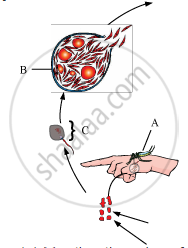Advertisements
Advertisements
प्रश्न
A person is suffering from a high-grade fever. Which symptoms will help to identify if he/she is suffering from Typhoid, Pneumonia or Malaria?
उत्तर
If the person has sustained high fever (39° to 40°C), weakness, stomach pain, constipation, headache and loss of appetite, it is Typhoid.
If the person has fever, chills, cough and headache; and the lips and fingernails turn gray to bluish, it is Pneumonia.
If the person has chills and high fever recurring every three to four days then, it is Malaria.
APPEARS IN
संबंधित प्रश्न
Study a part of the life cycle of malarial parasite given below. Answer the questions that follow:

(a) Mention the roles of ‘A’ in the life cycle of the malarial parasite.
(b) Name the event ‘C’ and the organ where this event occurs.
(c) Identify the organ ‘B’ and name the cells being released from it.
Mention any four methods involved in the treatment of cancer.
Exo-erythrocytic schizogony of Plasmodium takes place in ____________.
Haemozoin is ____________.
The sporozoites that cause infection when a female Anopheles mosquito bites a person, are formed in ______.
Many diseases can be diagnosed by observing the symptoms in the patient. Which group of symptoms are indicative of pneumonia?
Why is it that during changing weather, one is advised to avoid closed, crowded and airconditioned places like cinema halls etc.?
Represent schematically the life cycle of a malarial parasite.
Ringworm is one of the most common infectious fungal disease in humans. state any of its two symptoms.
How does the transmission of the following disease take place?
Malaria
